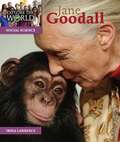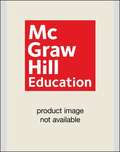- Table View
- List View
More NIMAC books are available at www.nimac.us. If you find your title in the NIMAC and not in Bookshare then please contact us to request it.
Weather and Seasons
by Lawrence Hall of Science University of California at BerkeleyNIMAC-sourced textbook
Weather and Water
by Lawrence Hall of Science University of California at BerkeleyNIMAC-sourced textbook
Weather and Water
by Lawrence Hall of Science University of California at BerkeleyNIMAC-sourced textbook
Weather and Water Resources
by Lawrence Hall of Science University of California at BerkeleyNIMAC-sourced textbook
Weather on Earth
by Lawrence Hall of Science University of California at BerkeleyNIMAC-sourced textbook
Wood and Paper: FOSS Science Stories
by Lawrence Hall of Science University of California at BerkeleyNIMAC-sourced textbook
Animals Two by Two
by Lawrence Hall of Science University of California at Berkeley Delta EducationNIMAC-sourced textbook
Plants and Animals (Delta Science Modules)
by Lawrence Hall of Science University of California at Berkeley Delta EducationNIMAC-sourced textbook
Solids and Liquids
by Lawrence Hall of Science University of California at Berkeley Delta EducationNIMAC-sourced textbook
Issues and Earth Science: Geological Processes, Revised
by Lawrence Hall of Science University of California BerkeleyNIMAC-sourced textbook <p>Where should we store our nuclear waste? Students learn about both gradual and sudden changes to the Earth’s surface, what causes them, and how they are monitored. They also explore how different kinds of rocks are formed and learn about some natural resources, where we find them, and how we use them. PE Assessment Example: Would you select one of the four suggested sites for storing nuclear waste? Explain. Use evidence from this unit to support your decision and identify any trade-offs. Geological Processes is part of Issues and Science three year middle school program, designed by SEPUP at the Lawrence Hall of Science. This six to seven week unit anchors the lessons around the the socio-science issue: Where should we store our nuclear waste? Investigative phenomena within the 18 activities connect back to the issue and storyline. This unit builds towards and assesses PEs ESS2-1, ESS2-2, ESS2-3, ESS3-1, ESS3-2. The Student Book guides students in exploring a socio-science issue and connected phemonena through a series of varied activity types. Activity types use one of twelve different instructional strategies to apply Science and Engineering Practices to specific Disciplinary Core Ideas and Cross Cutting Concepts. SEPUP's integrated literacy strategies help students process new science content, develop their analytical skills, make connections between related concepts, and express their knowledge orally and in writing. The built-in assessment system helps teachers identify students' strengths and weaknesses from the beginning of the unit. This allows them to adjust activities when needed so that all students get the best chance to build their knowledge and appreciation of science. At the back of the Student Book there is an Appendix containing additional resources for students, such as science skills, literacy strategies, and media literacy among others.</p>
Issues and Life Science: From Cells to Organisms, Revised
by Lawrence Hall of Science University of California BerkeleyNIMAC-sourced textbook <p>How should we prevent the spread of an infectious disease? Students investigate how scientists first learned about cells and how this discovery led to new understandings of how infectious diseases spread. They gather evidence about the structures and functions of cells, develop models of cells, and explain how cells in animals and plants get the matter and energy they need to survive and grow. PE Assessment Example: Based on what you have learned in the “Cells Alive!” activity and this activity, draw a diagram (or create another type of model) to show what happens to the food you eat. Your model should show the movement of matter and the release of energy stored in food. From Cells to Organisms is part of Issues and Science three year middle school program, designed by SEPUP at the Lawrence Hall of Science. This five to six week unit anchors the lessons around the the socio-science issue: How should we prevent the spread of an infectious disease? Investigative phenomena within the 15 activities connect back to the issue and storyline. This unit builds towards and assesses PEs LS1-1, LS1-2, LS1-6, LS1-7.</p>
Issues and Life Science: Ecology, Revised
by Lawrence Hall of Science University of California BerkeleyNIMAC-sourced textbook <p>What kinds of future space missions should we fund and conduct? Students take observations from their everyday life and build scientific models to try to understand how phenomena, such as changes in the moon’s appearance, seasons, and gravity work. Through data collection and analyzation students later use their understanding of what can be learned through space missions to determine the trade-offs of different proposed space missions. PE Assessment Example: Prepare a labeled diagram that includes a caption explaining how Earth’s tilt and its orbit around the Sun cause each of the following: a. changes in the angle of sunlight hitting the Earth’s surface. b. the seasons in the Southern Hemisphere to be opposite of the seasons in the Northern Hemisphere. Solar System and Beyond is part of Issues and Science three year middle school program, designed by SEPUP at the Lawrence Hall of Science. This five week unit anchors the lessons around the the socio-science issue: What kind of future space missions should we fund and conduct? Investigative phenomena within the 17 activities connect back to the issue and storyline. This unit builds towards and assesses PEs ESS1-1, ESS1-2, ESS1-3. The Student Book guides students in exploring a socio-science issue and connected phemonena through a series of varied activity types. Activity types use one of twelve different instructional strategies to apply Science and Engineering Practices to specific Disciplinary Core Ideas and Cross Cutting Concepts. SEPUP's integrated literacy strategies help students process new science content, develop their analytical skills, make connections between related concepts, and express their knowledge orally and in writing. The built-in assessment system helps teachers identify students' strengths and weaknesses from the beginning of the unit. This allows them to adjust activities when needed so that all students get the best chance to build their knowledge and appreciation of science. At the back of the Student Book there is an Appendix containing additional resources for students, such as science skills, literacy strategies, and media literacy among others. </p>
Issues and Life Science: Body Systems, Revised
by Lawrence Hall of Science University of California BerkeleyNIMAC-sourced textbook
Jane Goodall: Explore The World Level K Set (Explore The World)
by Trina LawrenceNIMAC-sourced textbook
The Queen's Crown (Fountas & Pinnell Classroom, Guided Reading Grade 2)
by Susan Layne Santy GutiérrezNIMAC-sourced textbook
The Queen's Nap (Fountas & Pinnell Classroom, Guided Reading Grade 2)
by Susan Layne Santy GutiérrezNIMAC-sourced textbook
The Very Picky Queen (Fountas & Pinnell Classroom, Guided Reading Grade 2)
by Susan Layne Santy GutiérrezNIMAC-sourced textbook
Up in Flames (Fountas & Pinnell Classroom, Guided Reading)
by Susan Layne Fabio LeoneNIMAC-sourced textbook
Juana Inés (¡Arriba la Lectura!, Read Aloud Module 7 #1)
by Georgina Lázaro Bruno PrezaNIMAC-sourced textbook
Study Guide for use with Psychology: The Science of Mind and Behavior
by Dianne Leader Ronald D. Smith Michael W. PasserEach chapter of the study guide begins with a list of Learning Objectives, which are expanded from the Focus Questions found in the margins of the textbook. When you feel you have mastered the material in the chapter, you will want to revisit these objectives and make note of any that require further study. Following the Learning Objectives is a brief Chapter Overview and Chapter Outline, which will help you see at a glance how the material in the chapter is organized. Like most study guides, this one contains an array of exercises, such as fill-in-the-blank, multiple-choice, and true-false self-tests, to help you memorize information you need to know to succeed. When you do these exercises, you will be engaging in active learning, which has been shown to be more effective than passive learning (i.e., reading the material the way you would read a novel). In addition, features such as Apply What You Know, Analyze This, and On the Web will prompt you to implement concepts you have learned, sharpen your analytic and research skills, use your creativity to explore resources that psychologists use in carrying out their work, and apply your critical thinking ability to evaluate "pop" psychology on the Internet.
Along the 21st Century Silk Road
by Jeanette LeardiIt was a 7,000-mile overland route heavily traveled by merchants, soldiers, and religious pilgrims during centuries past. Its name derives from the precious commodity carried along its network of paths and roads. Today, a project is under way to replace it with a highway system. What will a 21st-Century Silk Road mean to the people who live there now? Read this book to find out.
The Brain
by Jeanette LeardiThe human brain weighs less than four pounds, is made up of more than 100 billion cells, and is the control center of every human being. It keeps humans alive, allows them to experience emotions, and enables them to think and learn. How does this small organ manage to do so much? What should humans do to protect it? Read these informational texts to find out.
Lasers
by Jeanette LeardiLasers are a special type of light. They can cut through steal, look inside the brain of a fly, and help is explore hidden places. They are used in medical operations, at rock concerts, and in everyday items such as DVDs. How do lasers work? How have they become such a huge part of our lives in less than fifty years? Read this book to find out. (Includes 6 copies of the title, Teacher's Guide and Comprehension Question Card)


